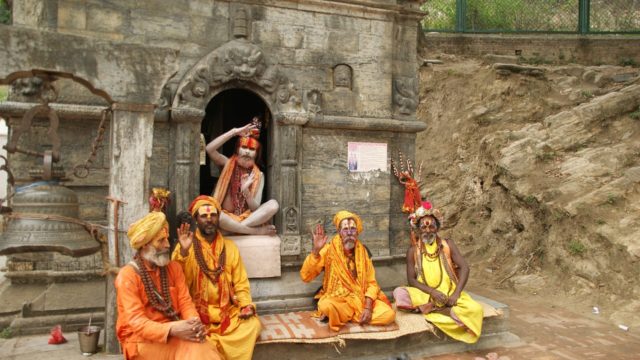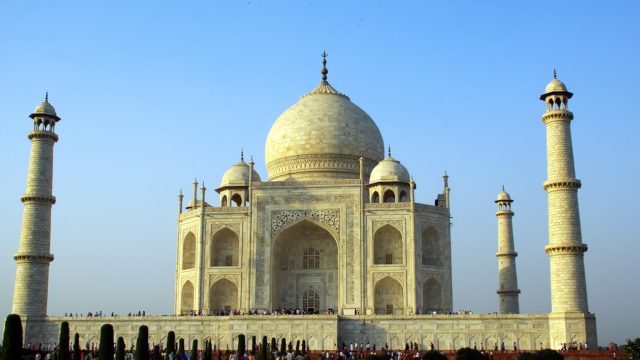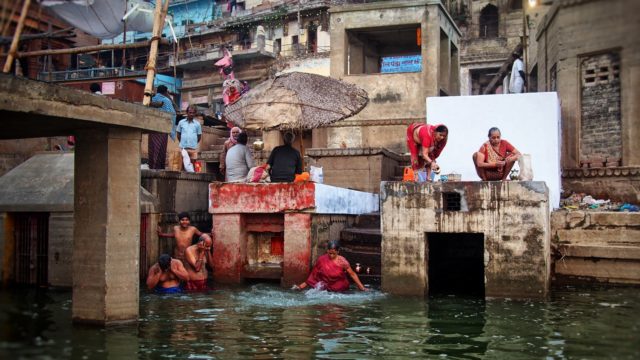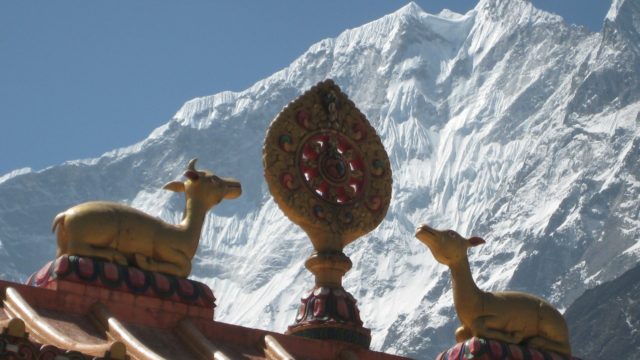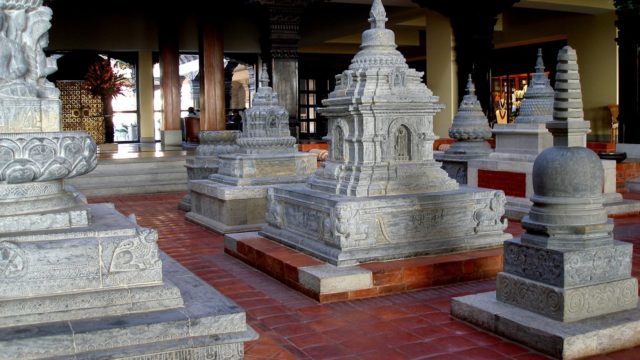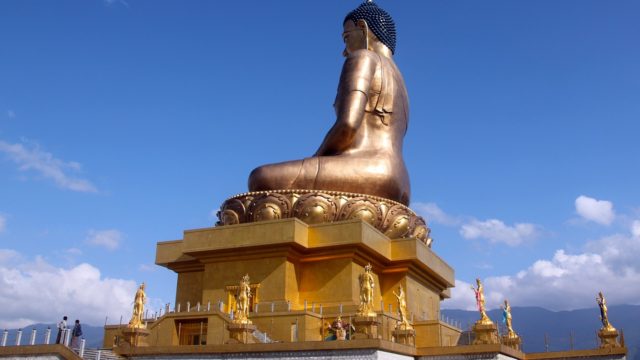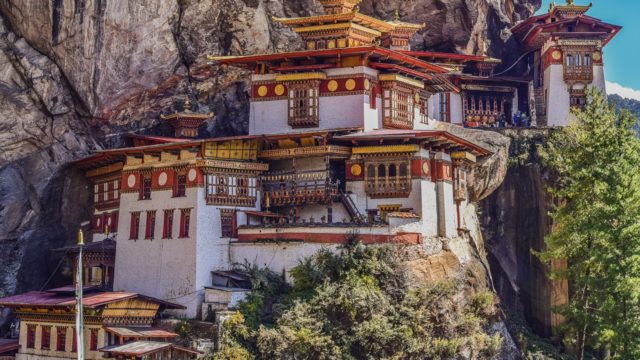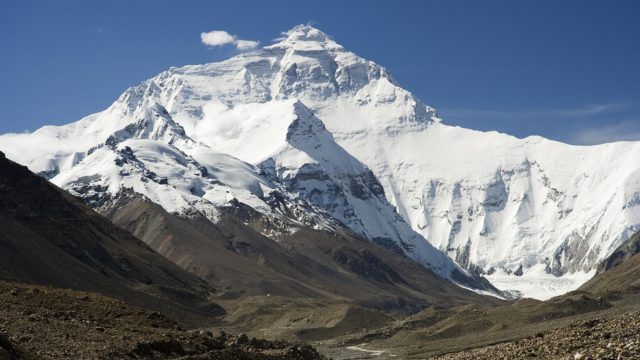Once you visit India, Nepal & Bhutan you will want to go back every year
- Upon arrival to Mumbay our representative will transfer you to the Hotel.
- Take the Thieves Market tour, a very fascinating and bustling nice flea market in Mumbai.
- Take an early tour around Mumbai.
- Visit the Prince of Wales Museum, with its rich collection of antique miniature paintings, Nepalese and Tibetan art; and Jehangir Gallery, housing the works of contemporary Indian artists.
- travel up Malabar Hill for magnificent vistas and a look at the fanciful Hanging Gardens and topiaries.
- Walk along our Mumbai Fort Heritage Walking Tour this is perhaps one of the most popular walking tours of the country.
- Enjoy a boat cruise on the serene and beautiful Lake Pichola. The island palace on the Lake called Jagmandir Palace is quite fascinating.
- We will hire bikes from Devigarh and explore the fascinating Delwara village. The latter is a small and rather remote village dominated by an imposing structure of the Devi Garh heritage hotel. Afternoon, we will drive to Jodhpur Enroute we will visit Ranakpur.
- Guided tour of Jodhpur. Our tour includes the massive fort. In olden days this must have been impregnable since its rocky base is scraped straight down making it nearly impossible to ascend.
- We will explore Mihirgarh, which is a fascinating small feudal town, which seems to be straight out of the Arabian Nights.
- Drive to and visit Amber Fort, the former capital of the royal Jaipurs. Here we switch to a jeep and drive to the top.
- Visit Mahtab Bagh. The Moonlight Garden was an extension of the Taj Mahal Garden – on the other side of the river.
- Visit the Taj Mahal, one of the Seven Wonders of the World to witness this spectacular monument built for love. Ask us about an evening visit under the full moon light. (See our full moon calendar on our website).
- Visit the magnificent tomb of the Mughal Emperor Humayun. Delhi has such an abundance of amazing monuments that this Tomb Complex (1562 A.D.)
- Visit the ghats of Varanasi to witness the performance of Ganges Aarti. We enjoy a special evening cruise on the Ganges. See the Hindu devotees performing the “Puja” with lighted lamps.
- Visit the sacred Ganges for a boat ride. Every morning at dawn hundreds of worshipers can be seen bathing in the sacred waters.
- Visit Kathmandu and its many amazing and its exquisite architecture, museums, temples and artistic embellishments.
- Enjoy a Scenic Flight over Mount Everest: Nepal offers the unique experience of scenic mountain flights over the world’s highest peak, Mount Everest.
- Visit the Bhutan Post, known for its world famous stamps, where you can buy postcards and stamps.
- Visit the Nunnery (Drubthob Goemba) and enjoy the view of Thimphu valley. From there you have a very nice view of Tashichodzong and the Parliament house.
- Hike through a forest of pines and farmlands along the bank of the Pho Chu River for about 2 hours till you reach Samdhingkha.
Day 1. Sat. En Route.
Today you will make your way to the airport for your international flight to India.
Overnight: En Route.
Day 2. Sun. Mumbai
Meeting & assistance upon arrival. Our services begin here. You are greeted at the airport by our facilitator, and then ushered to a private chauffeur driven vehicle. You are then driven to your hotel where you are assisted with your check in.
Overnight: Taj Mahal Palace & Tower. (B)
Day 3. Mon. Mumbai.
Today, we enjoy a walking tour through Mumbai’s famous Thieves Market – Chor in Hindi means thief and bazaar means a market. It is a very fascinating and bustling nice flea market in Mumbai. It is a popular saying amongst the locals that “If you lose anything in Mumbai, you can buy it back from the Chor Bazaar!!!”
In case you happen to be an antiquarian or restorer, then you are moving for just the right place. Victorian furniture can also be found here, that too, authentic one, which would definitely add grace to your rooms. Our tour guide in Mumbai will always be with you and help you to bargain the prices for you!
Overnight: Taj Mahal Palace & Tower. (B)
Day 4. Tue. Mumbai.
The best time to travel around Mumbai is either in the early mornings, when it’s just you, us, and Mumbai! Our tour guide in Mumbai would pick you up early morning at 7am for the Mumbai Morning Tour where we’ll take you to explore the most gorgeous and fascinating colorful flower market of Mumbai, which according to us is an absolute treat to your eyes, mind, heart and soul. Later on followed to the Dhobi Ghat – The oldest open Air laundry in Mumbai made during the British presence in India, Even in today’s age of technology, where washing machines are a part of each and every household, you just can’t believe, men washing & beating up the clothes on the rocks to make them clean, white & stain free!
Around 9:30 a.m., we’ll check out the Sassoon Docks: The fishing hub of Mumbai to see the fisherwomen getting their early catch from the sea & sorting them amidst unlimited pandemonium and people!
Afternoon, we proceed on a guided tour of a cosmopolitan & tropical Bombay, with pockets of palm trees and a warm salty breeze wafting in off the Arabian Sea. Our first stop is at Bombay’s landmark the Gateway to India, an elegant 26 mtrs stone archway, hastily erected as a symbol of welcome to Queen Mary and King George V of England on their visit to India in 1911.
Visit the Prince of Wales Museum, with its rich collection of antique miniature paintings, Nepalese and Tibetan art; and Jehangir Gallery, housing the works of contemporary Indian artists.
Travel up Malabar Hill for magnificent vistas and a look at the fanciful Hanging Gardens and topiaries. Stop at Mani Bhavan, Mahatma Gandhi’s home, now a museum dedicated to his life; and stroll through teeming bazaars crammed with antiques, jewelry, produce, flowers, and an array of handcrafted wares.
Overnight: Taj Mahal Palace & Tower. (B)
Day 5. Wed. Mumbai /Adipur.
We take deep pleasure in inviting to walk along our Mumbai Fort Heritage Walking Tour this is perhaps one of the most popular walking tours of the country. When you walk in this area, one could witness an amazing variety of historic landmarks and buildings, constructed in different styles of architecture and built in a variety of local and imported materials. Later, transfer to the airport to board your flight to Udaipur. Meeting and assistance upon arrival check into the Lake Palace.
Evening we enjoy a boat cruise on the serene and beautiful Lake Pichola. The island palace on the Lake called Jagmandir Palace is quite fascinating. The Taj Lake Palace, located in the middle of Lake Pichola is a dream of white marble and mosaic glistening in the moonlight, very reminiscent of the most beautiful tourist cliché in the world; the Taj Mahal.
Overnight: Taj Lake Palace. (B)
Day 6. Thu. Udaipur.
Udaipur is a cool oasis in the dry heart of Rajasthan. It is probably the most romantic city in a state where every city has some romantic or exotic tale to tell. The huge city palace towering over the Lake Pichola is the largest palace complex in Rajasthan. Later during afternoon, we will visit the Bhartiya Lok Kala Museum, one of the most famous museums of Udaipur, exhibiting the brilliant collection of folk articles of Rajasthan. Later, we proceed on a short excursion to Eklingi & Nagda (25 kms).
Eklingi is the temple of Shiva with its pyramidal roof and four faced shiva image. The temple was family temple of the ruling kings of Mewar. At Nagda the Sas Bahu temple and the Jain temples present beautiful architecture.
Overnight: Taj Lake Palace. (B)
Day 7. Fri. Udaipur / Devigarh / Ranakpur / Jodhpur.
We will hire bikes from Devigarh and explore the fascinating Delwara village. The latter is a small and rather remote village dominated by an imposing structure of the Devi Garh heritage hotel. Afternoon, we will drive to Jodhpur Enroute we will visit Ranakpur
Upon arrival in Ranakpur, we enjoy excursion to Ranakpur Temple the exquisite Jain Temple. Built during the reign of the liberal and gifted monarch Rana Kumbha in the 15th century The basement is of 48, 000 sq. feet area that covers the whole complex. From here we continue our drive to Jodhpur. Upon arrival in Jodhpur check into Umaid Bhawan Palace at 8 PM.
Overnight: Umaid Bhawan Palace. (B)
Day 8. Sat. Jodhpur / Mihirgarh / Jodhpur.
After breakfast, proceed on a guided tour of Jodhpur. Our tour includes the massive fort. In olden days this must have been impregnable since its rocky base is scraped straight down making it nearly impossible to ascend. Once inside, royal palaces abound with fascinating history and priceless jewels, on to the armoury and Jaswant Tara – the Royal Crematorium We will drive to Mihirgarh. Emerging out of the Thar Desert in western Rajasthan Mihirgarh is the first mud fort to be built anywhere for hundreds of years. 9 huge and incredibly luxurious suites, private Jacuzzi’s or plunge pools with each suite, re-define the word indulgence .Numerous alcoves, lounges and common areas are simply the best place to stay and experience the beauty of rural Rajasthan.
During afternoon, we would explore Mihirgarh, which is a fascinating small feudal town, which seems to be straight out of the Arabian Nights. There is no proper road here – only one main dusts trail. On either side are typical thatched houses and shops of all kinds – colorful bangles, silver jewelry, potters, fruit vendors on carts, dress shops, tailors etc.
Overnight: Umaid Bhawan Palace. (Palace Room, B)
Day 9. Sun. Mihirgarh / Rohet / Chhatrasagar
In the morning we bike through the back roads and trails of remote Rajasthan for about 20 kms. The journey will bring to us the life and times of the contemporary natives of Rajasthan who have maintained traditions over centuries. We will hand over our bicycles to the Royal family of Rohetgarh and ride 130 Kms to Chhatrasagar, a hundred-year old reservoir with a periphery of about 10 kilometers, is an ideal destination for nature lovers and a perfect getaway from the chaotic city life.
As a hunting preserve of the Nimaj Estate, Chhatra Sagar has witnessed many exciting shikar camps and leisure parties. Today, the campsite, situated on the dam, offers breathtaking views of the sunrise, sunset and the Aravalli ranges on the horizon. The old shooting box – Aodhi has been put to good use as it provides a closer view of the waterfowl and birds of prey. Relax in the tastefully designed and well-appointed tented accommodation. Each tent has an attached bath with running hot and cold water, and its own private sit out overlooking the lake.
Overnight: Chattarsagar. (B, L & D)
Day 10. Mon. Chhatrasagar / Jaipur.
Morning is at leisure. This is an ideal destination for nature lovers and a perfect getaway from the chaotic city life. The place is also a popular haunt for a variety of water birds.
Later, we will drive to Jaipur, the City of Victory. Chaotic and congested, though it still has a habit of tickling travelers pink. This beautiful ‘Pink City’ is home to opulent palaces and the Amber Fort. Upon arrival, check in Jaipur & transfer you to Rambagh Palace. Rajasthan evokes images of erstwhile royalty – polo-playing princes and beautiful princesses who captured their hearts. The history of Rajasthan – or ‘Rajputana’ as it was once called – is rich with legendary tales of love and velour. For nearly two centuries, the Rambagh Palace has been home to generations of royals. Built in 1835 on a modest scale for the queen’s favourite handmaiden Kesar Badaran, it was later refurbished as a royal guesthouse and hunting lodge.
Rest of the day is at leisure to enjoy your property.
Overnight: Rambagh Palace. (B)
Day 11. Tue. Jaipur.
This morning, we proceed on a tour Of the City Palace & Observatory. The City Palace in the heart of the old city is a blend of Rajasthani and Mughal architecture. The center of the palace is a seven-storied building called Chandra Palace, with fine vies over the gardens and the city. Next, we visit the Solar Observatory – an astronomical treasure house, with solar device that give accurate predictions till date.
During evening, we experience a unique walking tour of Jaipur, where we wander through the winding narrow lanes bustling with activity. The walk would enable to us an opportunity to interact with local residence, skilled craftsmen and traditional traders. The idea is not only to bring to the visitor the history and tradition of the place, but, to also bring to you face to face with the people who have made it possible for this heritage to generate and sustain for centuries. This is a craft lover’s delight, where from wedding card manufactures to book binding and printing to gold and silver casters and gem stone traders are all to be found offering a delightful reminder of crafts of the bygone era.
Overnight: Rambagh Palace. (B)
Day 12. Wed. Jaipur.
This morning we drive to and visit Amber Fort, the former capital of the royal Jaipurs. Here we switch to a jeep and drive to the top. Few fail to be moved by the dramatic Rajput grandeur of this hilltop fortress-palace 11 km north of Jaipur. Set on the dry wrinkled Aravali Hills, and surrounded by fortified battlements, the palace straddles two sepia-hued tundra hills overlooking Maota Lake, and its sprawling crenellated walls lattice the surrounding hills.
We will ride up to this hilltop palace in a Jeep. Our guide will elaborate on the history of this architectural masterpiece with its mirror-studded alcoves, dazzling mosaics and water-cooled swings that delight today’s visitors as they did their former royal residents. Following the tour of Amber Fort, we will visit Dera Amer for a short elephant safari through the country side. In a picturesque valley close to Jaipur, Dera Amer elephant camp is the location of this not to be missed adventure. After feeding the elephants, you will ride through the surrounding colonies and forests and a medieval fortress temple before arriving at the camp in time for a mouth-watering lunch. Afternoon is at leisure.
Overnight: Rambagh Palace. (B)
Day 13. Thu Jaipur / Bharatpur / Fatehpur Sikri / Agra
After breakfast this morning, we will drive to Bharatpur. Popularly known as Bharatpur, the 29-square kilometer Keoladeo Ghana National Park is one of the worlds most famous and interesting wetland areas. Later, we will enjoy lunch at The Bagh.
Following lunch, we will drive to Agra en route you visit to Fatehpur Sikri. Enjoy a guided exploration of this beautiful uninhabited city. Fatehpur Sikri is built in red sandstone, and is a beautiful blend of Hindu and Islamic architectural elements.
The ‘City of Victory’ had only an ephemeral existence as the capital of the Mughal Empire. The Emperor Akbar (1556-1605) decided to construct it in 1571, on the same site where the birth of his son, the future Jahangir, was predicted by the wise Shaikh Salim Chisti (1480-1572).
The work, supervised by the great Mughal himself, was completed in 1573. In 1585, however, Akbar abandoned Fatehpur Sikri to fight against the Afghan tribes and choose a new capital, Lahore. Fatehpur Sikri was to be the seat of the great Mughal court only once more for three months in 1619, when Jahangir sought refuge there from the plague that devastated Agra. The site was then finally abandoned, until its archaeological exploration in 1892.
Upon arrival in Agra check into The Oberoi Amarvilas.
Overnight: The Oberoi Amarvilas. (B, L)
Day 14. Fri. Agra.
Morning is at leisure.
In the evening we will visit Mahtab Bagh. The Moonlight Garden was an extension of the Taj Mahal Garden – on the other side of the river. In 1652 Aurangzeb wrote to his father telling of a visit to ‘the blessed tomb’ and commenting that ‘the Mahtab Garden was completely inundated and has lost its charm, but soon it will regain its verdancy. The octagonal pool and the pavilion around it are in splendid condition.’ The Mahtab Bagh was lost under the mud but re-excavated in the 1990s.
Originally, the garden was planted with fragrant flowers and used in the cool of the night as a place from which to view the Taj Mahal reflected in the octagonal pool and in the river.
Overnight: The Oberoi Amarvilas. (B)
Day 15. Sat. Agra/Delhi.
At sun rise we visit the Taj Mahal, one of the Seven Wonders of the World to witness this spectacular monument built for love. Besides perfect symmetry in every aspect of its construction, the inlay work of semi-precious stones into marble in pietra dura style is absolutely remarkable.
Next, we will visit the first red sandstone fort of North India, the Agra Fort. Its royal audience halls, immense stone courtyards, marble mosque and the private royal chambers give us a glimpse of the grandeur of the Mughal Empire. Later, we will drive to Delhi along one of the India’s finest freeways.
Upon arrival in Delhi check into The Oberoi Gurgaon
Overnight: The Oberoi Delhi. (B)
Day 16. Sun. Delhi.
At Mid-morning proceed on a tour of Delhi, the vast and bustling Capital and the third largest city of India. This exciting city of contrasts encompasses two very different parts – Old Delhi and New Delhi – and both can be amalgamated quite easily whilst sightseeing. The highlights of the tour include, inspiring Qutab Minar (1193 A.D.) – unfortunately they are no longer accessible for visitors. The Qutab Minar and its Monuments are also a UNESCO World Heritage Site.
Visit the magnificent tomb of the Mughal Emperor Humayun. Delhi has such an abundance of amazing monuments that this Tomb Complex (1562 A.D.) does not quite get the acclaim that it deserves.
Continue with a drive to Lutyens’ New Delhi. Time permitting; this drive will include photo opportunities at some of the following attractions. The exterior of the massive and awe-inspiring Rashtrapati Bhawan. Delhi’s landmark structure India Gate and Connaught Place, which is New Delhi’s downtown. Later, we will proceed on a guided city tour of Old Delhi including Jama Masjid, the largest mosque in India. We will also ride cycle rickshawalas along the narrow as well as bustling alleyways of Old Delhi. Continue ridding to the Red Fort (1639-1648 built by Shah Jahan the builder of the Taj Mahal in Agra) to view the inlaid and carved Royal Chambers, on to Raj Ghat for a tour of Mahatma Gandhi’s mausoleum.
The Oberoi Delhi. (B)
Day 17. Mon. Delhi / Varanasi / Sarnath.
After breakfast this morning you will check out of the hotel and meet your guide in the lobby. From here you will be privately transferred to the airport for your flight to Varanasi. On arrival you will be met and privately transferred to your new hotel where you can freshen up. Afterwards you will be met for an excursion to Sarnath.
We will start with the The university, which occupies a large piece of land at the southern end of town, is also home to the New Vishwanatha Temple.
The New Temple is modern in design and open to Hindus and non-Hindus alike. Surrounded by palm trees, it is a splendid white marble structure that shines in the afternoon sun against a pale blue sky. Inside, the temple is spacious and airy. The interior walls are covered with Vedic art above inscriptions from the Bhagavad Gita and Upanishads. In the center of the first floor is the Shiva linga. Here you will have free time to walk around the Stupas and take in the history of the Buddha.
Evening, we visit the ghats of Varanasi to witness the performance of Ganges Aarti. We enjoy a special evening cruise on the Ganges. See the Hindu devotees performing the “Puja” with lighted lamps.
Overnight: Nadesar Palace. (B)
Day 18. Tue. Varanasi.
At dawn we visit the sacred Ganges for a boat ride. Every morning at dawn hundreds of worshippers can be seen bathing in the sacred waters. The great river banks are lined with an endless chain of stone steps—the ghats—that stretch from one end of the city to the other. Following the boat ride, we will enjoy 01 Hour of private Yoga lessons.
We set off on foot to explore the inner city. Through a twisted maze of narrow alleys, home to numerous shrines and pilgrim shops, we walk back a few centuries. Life here has stood still for years. The homes, the shops and even the cattle have not changed over the centuries. It is a brilliant nostalgic experience of timelessness!
During Afternoon an excursion to a weaver’s village located 20 kms from Varanasi. Here, almost the entire village is engaged in the home industry for weaving. The latter is done for major exporters and producers of silk garments. We will have the opportunity of visiting traditional homes, interact with the locals and see how these simple folks conduct their day-to-day lives.
Overnight: Nadesar Palace. (B)
Day 19. Wed. Varanasi / Kathmandu.
Transfer this morning to the airport to board your flight to Kathmandu, the beautiful capital city of Kingdom of Nepal. Upon clearing airport formalities, transfer to your hotel, take some rest and freshen up.
Afterwards you will meet your guide in the lobby and tour Kathmandu Durbar Square, the historic seat of Nepalese royalty built between the 12 – 18 centuries. The Durbar square is famous for its exquisite architecture, museums, temples and artistic embellishments.
After the sightseeing tour of Kathmandu City, visit Swayambhunath Stupa, one of the world’s oldest Buddhist chaityas, acclaimed to be more than 2500 years old. Situated on a hillock, 3 kms west of Kathmandu this is one of the holiest Buddhist sites in Nepal.
Overnight at Hotel Hyatt (B).
Day 20. Thu. Kathmandu
Early morning transfer to the domestic airport for Scenic Flight over Mount Everest: Nepal offers the unique experience of scenic mountain flights over the world’s highest peak, Mount Everest. Early this morning, you have the option to enjoy spectacular views of the snowcapped Mount Everest and Himalayan ranges, aboard a small plane, with every seat having its own window! The hour long flight, takes off from Kathmandu airport. After you return and enjoy breakfast, Visit Boudhanath Stupa, meaning the ‘Lord of Wisdom’. This Tibetan Buddhist monument is the largest stupa in Nepal and one of the largest in the world.
Also visit Pashupatinath Temple, a temple dedicated to Lord Shiva and one of the most sacred Hindu shrines in the world, on the banks of Bagmati River. Although only Hindus are allowed inside the temple, visitors can clearly see the temple and the activities performed inside, from the eastern bank of Bagmati River. The Arya Ghat, immediately below the temple at the foot of a steep flight of steps, was built in the reign of Pratapa Malla. It is reserved for the cremation of royalty.
Later, visit Bhaktapur which was the former capital of the valley, and was once a flourishing city on the trade route to Tibet. Today, Bhaktapur is like an open air museum with large areas open to pedestrian access – it is a store house of mediaeval art and architecture.
This afternoon also visit the Patan Durbar Square. Patan is known for its museum, temples and superb craftsmanship of its artisans. Patan Durbar Square has been acclaimed as one of the finest urban streetscapes in the world.
Overnight at Hotel Hyatt (B).
Day 21. Fri. Kathmandu / Bhutan / Paro / Thimphu.
After breakfast transfer to the International airport to catch the flight to Bhutan. On arrival at Paro International Airport you will be received by a representative of Diethelm Travel Bhutan who will be holding a placard outside the Airport and welcome you in a traditional manner by offering a khadar (greeting scarf). After which you will be escorted to your hotel in Thimphu.
Drive towards Thimphu. On the way see Tachogang Temple or the “Temple of the Hill of Excellent Horse” which rises in austere surroundings on the left bank of the river, a few km before Chhuzom at the confluence of the Paro and Thimphu rivers. After lunch Visit the National Library, a treasure trove of priceless Buddhist manuscripts. The National Library of Bhutan (NLB) was established in 1967 with the primary objective of collecting and preserving mainly ancient Bhutanese written and printed resources.
Then move to The National Folk Heritage Museum to get an insight into the typical Bhutanese way of life. Folk Heritage Museum at Thimphu provides you a glimpse of the lifestyle, items and artifacts of Bhutanese villages and rural households. See the Institute for Zorig Chusum: Commonly known as the Painting School, the Institute offers a six-year course on the 13 traditional arts and crafts of Bhutan.
Drive to see the Takin Preserve, which houses the national animal of Bhutan, the Takin is seen only in Bhutan a high altitude.
Further, drive up to BBS tower to get a view of the capital City of Thimphu.
Overnight: Amankora Thimphu. (Deluxe Room, LD)
Day 22. Sat. Thimphu.
Visit the Bhutan Post, known for its world famous stamps, where you can buy postcards and stamps. The Bhutan Post is definitely a place of significance where an extensive collection of exotic stamps made from metal and silk to three dimensional images and even stamps with mini-phonograph records are produced. A unique feature of this Post Office is that visitors can create personalized stamps by taking their own pictures and then using this stamp to post cards etc. to their friend and families.
Visit Memorial Chhorten in Thimphu built in 1974 in memory of the Third King His Majesty Jigme Dorji Wangchuck who passed away in 1972. The Memorial Chhorten is one of the most visible religious structures in Thimphu, and for many people it is the focus of their daily worship.
Visit Centenary Market one of the biggest structures in Bhutan, Centenarary Farmers market was built in 2008 to mark the coronation of fifth King of Bhutan and 100 years of monarchy.
Visit the Nunnery (Drubthob Goemba) and enjoy the view of Thimphu valley. From there you have a very nice view of Tashichodzong and the Parliament house.
To feel the spirit of the game, we will dress up our clients in a new Bhutanese national dress bought for our male clients called Gho, and the Kira for women.
Overnight: Amankora Thimphu. (BLD)
Day 23. Sun. Thimphu / Punakha.
After breakfast you will check out of the hotel and meet your guide. Drive to Punakha via the Dochula pass (3140 m). The drive takes you through the scenic Paro Chhu and Wang Chhu river valleys on to the high mountain pass of Dochula.
From the Dochula pass one can see some of the highest peaks in Bhutan such as:
| Kang Bum | 6526 m | Gangchhenta | 6840 m |
| Masang Gang | 7165 m | Tsenda Gang | 7100 m |
| Teri Gang | 7300 m | Jejekangphu Gang | 7100 m |
| Zongophu Gang (Table Mt) | 7100 m | Gangkhar Puensum | 7541 m |
Visit Druk Wangyel Chhorten, built by the Queen Mother for the peace and stability of the country. Here you could view some birds in the distance.
After getting some rest then walk to Khamsum Yuelley Namgyal Chhorten (50 minutes) – a three-storey chhorten built by Her Majesty the Queen Mother Ashi Tshering Yangdon Wangchuck in 1999 for the protection of the country, stands on a beautiful hillock called Ngezergang, and is located about 6 miles from Punakha. Then, Drive to see the impressive Punakha Dzong, the second of Bhutan’s dzongs. For many years until the time of the second King, it served as the seat of the government. It is the winter residence of the monastic order’s leader and his entourage of monks, and was built in 1637 by Shabdrung Ngawang Namgyal.
Overnight: Amankora Punakha. (BLD)
Day 24. Mon. Punakha Rafting At Phochu River.
After breakfast, you will hike through a forest of pines and farmlands along the bank of the Pho Chu River for about 2 hours till you reach Samdhingkha. Your rafting crew will be waiting here for you. Then start rafting along the Pho Chu River coming across stretches of Class II and IV rapids. Upon arriving at a beach-like stretch of sand, some distance from a Chorten, you will be served lunch on the sandy embankment. The post-lunch rafting session will continue till you reach the relatively placid section of the river below the Punakha Dzong.
In the evening enjoy sumptuous dinner with a bonfire in the company of a local people. This is an interactive session where one can ask question to the local experts.
Overnight: outdoor camping at Zamling Thang. (BLD)
Day 25. Tue. Punakha / Paro.
The day in Punakha valley begins with a drive through the town of Khuruthang and continues along the banks of the Mo Chu River, passing the Phuntsho Pelri Palace and several other winter homes of the Royal Family. At the upper end of the valley, a hike across a footbridge through terraces of rice, chillies and cabbage. Then drive back to Paro. Check into hotel. Get some rest.
After lunch visit The National Museum which is a repository of not only precious work of art but also costumes, armor and other hand crafted objects of daily life that provide a good snapshot of the rich cultural traditions of the country. Visit Rinpung Dzong built in 1645 to defend the valley against Tibetan invaders and is now used as an administration center and school for monks.
Visit Dungtse Lhakhang that lies just out of town, across the river. Dungtse Lhakhang is possibly the only ancient temple built in the shape of a chhorten. Visit mani dungkhor in Paro. It is believed that spinning a prayer wheel has the same benefits of chanting a prayer.
Evening you will have free time to walk around the Town.
Overnight: Amankora Paro. (BLD)
Day 26. Wed. Paro Day Hike.
Morning hike up to the Taktsang Monastery (Tiger’s nest). The climb up to the view point will take around three hours. Enjoy the stunning view of the monastery, where Guru Padmasambava landed on the back of a tiger in the 8th century, and meditated for three months. Lunch will be arranged in the cafeteria and after lunch in the cafe, walk back to the road point.
Drive to Drukgyal Dzong (fortress) now in ruins, which was built in 1646 by Shabdrung to commemorate his victory over the Tibetan invaders, led by Mongolian Warlord, Gushri Khan. Strategically built over the only passage into Paro valley, the Dzong helped to repel numerous invasions all through the course of Bhutanese history.
Visit Kila nunnery or Chele la Gompa located on the cliffs below Chele pass at about 3,500m above sea level. There are seven small temples and several retreat huts built into a dizzying Cliffside, a day’s walk from anywhere, where some 30 to 70 nuns live in self-imposed isolation. Then drive till the pass takes around one hour from Paro. There are great views from here of Paro valley. Below, Jele Dzong, across on the far ridge and also seen to the north, are Mt. Chomolhari and Jichu Drake on a clear day.
Overnight: Amankora Paro. (BLD)
Day 27. Thu. Paro / Back Home.
This morning your guide will escort you to the airport for your flights home. (B)
PLEASE REQUEST A QUOTATION.
- Accommodation in Hotels as stipulated in the Itinerary.
- Tours transportation included as stipulated in the itinerary.
- Services of an English speaking guide, park entrance fees and point of interest as indicated in the itinerary.
- All Government taxes and levies.
- All meet and greet services.
- 24 hours stand-by contact number.
- Meals as indicated in the itinerary. (B = Breakfast / L = Lunch / D = Dinner)
- Train transfer between different cities as schedule in itinerary.
- Transfer to/from Hotel and accommodation.
- All items of personal nature e.g. telephone call bills, fax/email bills etc.
- Gratuities and Tips to Hotels/Lodges/Camps staff and Driver/Guide(s).
- Alcoholic and nonalcoholic drinks.
- Any local or international flight/s and departure taxes and other taxes.
- Laundry services.
- Flights – National or International – (Local flights – Subject to your program)
- Concession fees (In case of any new fees introduce by parks and/or atractions without our knowledge).
- Any other item(s) not included in our itinerary.
- Visa fees and visa processing (Information available at time of reservation).
- Travel Insurance – We highly recommended you to have your personal travel insurance.

